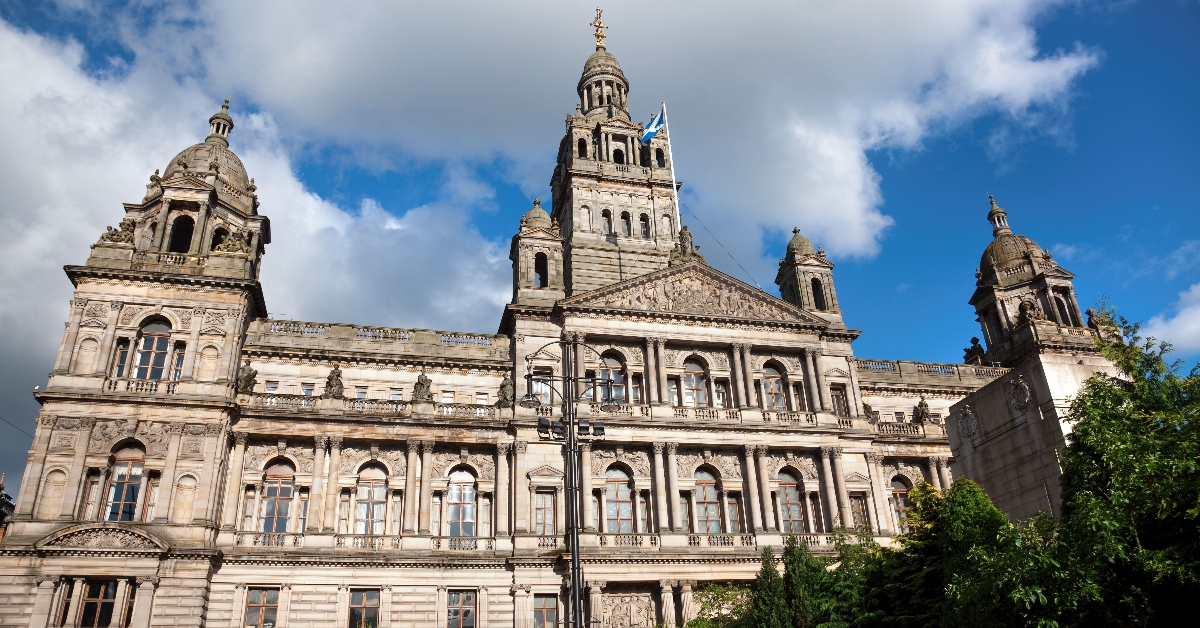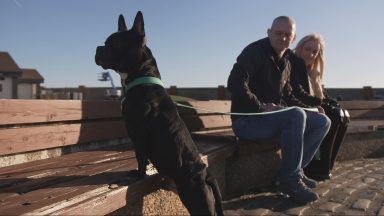From tiled Victorian tenements to Greek gods looming over the Clyde, Glasgow’s rich history is illustrated in its architecture.
Glaswegians have lived, worked, worshipped and leisured in buildings around the city which date back centuries and have their own remarkable stories to tell.
Niall Murphy, director of the Glasgow City Heritage Trust, regularly takes to the streets to highlight subtle features and lesser-known facts about Glasgow’s architectural past through his #MomentsOfBeauty pictures on Twitter.
He discovered his fascination with buildings as a boy growing up in the dense, urban sprawl of Hong Kong before being sent to Edinburgh to attend boarding school in 1981.
Mr Murphy recalled the wonder he felt during his first visit to Glasgow after an interview to study architecture at Glasgow School of Art in 1989.
“I remember the ‘canyon effect’ I had walking down St Vincent Street, with all the tall buildings close together, that really strong sense of enclosure like a big American city and I thought, ‘I could live here,'” he said.

The stories told by Glasgow buildings
“I think Glasgow is a fantastically preserved city,” Mr Murphy said. “What’s interesting about it is that it seems to be like several films spliced together from the Georgian, Victorian and Edwardian era, through the inter and post-war eras to the modernist era.
“They are all layered on top of each other with the M8 running through it. All those different characters together are really interesting.”
Some of the carvings which stand out by the Clyde is are on the Beaux-Art Renaissance Clyde Navigation Trust Building by architect Sir John James Burnet and sculpted by John Mossman and Albert Hodge.
Figures from Greek mythology include a depiction of Father Clyde sitting on a throne, sea gods Poseidon, his son Triton and wife Amphitrite being pulled by seahorses and Demeter, the goddess of fertility leading a bull.
“It’s fantastic and all representative of Greek mythology and shows off Glasgow’s trade links – which was really important for the authority in charge of Glasgow’s port.” Mr Murphy added.

Another example of Burnet’s work is the former Athenaeum Theatre on Nelson Mandela Place, a tall American-style elevator building dressed in a Neo-baroque facade “all about the arts.”
Designed by architect William Young, Glasgow City Chambers features its own tribute to its former status as second city of the empire, opened by Queen Victoria in 1889.
The central portion of the building has a Jubilee Pediment, depicting Victoria on the throne surrounded by figures depicting the nations of Great Britain and the Empire.
“It was a statement; it represented the people of the world offering tribute to Queen Victoria,” Mr Murphy said.
The emergence of sandstone
Scotland’s building regulations were changed after several fires throughout the 16th and 17th centuries.
Builders were no longer permitted to use timber on elevations and stone was instead favoured.
Dulled by decades of pollution during the industrial era, buildings were given a polish during the 1980s to make their colours “sing again.”
“That homogeneity of stone in Scottish cities makes them hang really well together,” Mr Murphy said.
“The beauty of warm blonde and red sandstone tenements lining the streets and a tremendous warmth which makes it special.
“It gives the streets a sense of unity.”

The Glasgow tenement
Glasgow tenements are characteristic of housing in Glasgow, a response to workers and families immigrating to the city in the 19th century.
Constructed of blonde or red sandstone from quarries firstly in Glasgow and later in south Ayrshire and Dumfriesshire, they were made to such a high standard that, at one point, it was more expensive to build in the city than in London.
While tiling is not unique to Glasgow, it’s a common feature of many tenement closes and was designed to make cleaning easier for residents.
“Glasgow tenement closes didn’t have a front door, but were ordinarily open on to the street for ventilation.,” he explained.
Chimneys are another example of the Victorians’ knack for turning utilitarian function into a design feature.
Niall recently shared a photo of an unusual tenement close with a chimney flue concealed inside an arch, supported by ornate console brackets.
“In the Victorian household, your maid would be making up the fire and that was how the buildings were heated. As such, Glasgow was a really polluted city, belching out smoke first thing in the morning,” he explained.
Another draw of the Glasgow tenement flat is its large windows, letting plenty of light into the interior.
He added: “The great Glasgow architect Jack Coia once said “Glasgow is a city of wee folk and big windaes” Though not always so great for our cold Glasgow winter weather.”
Iron works
At its peak, Scotland’s iron and steel industry employed almost half of the working population, with Lanarkshire giants Ravenscraig, Gartsherrie and Summerlee dominating output in the 19th and 20th centuries.
Glasgow was also synonymous with ironwork and beautifully ornamented examples of its craft were exported all over the world.
Saracens Factory in Possilpark became the most important producer of ornamental ironwork in Scotland, making railings, drinking fountains and bandstands which were shipped around the globe.
The Kibble Palace in the city’s Botanic Gardens, along with drinking fountains at Saracen Cross and Glasgow Green and the huge Saracen Fountain in Alexandra Park are great examples of its craftsmanship.

Sadly, much of the ornate ironwork once found in Scotland was lost to the war effort.
To psychologically prepare the country for “total war” against the Axis powers, Lord Beaverbrook launched a campaign encouraging Brits to donate their railings to help build munitions.
“It swept a lot of filigree from streets, but much of it wasn’t used; it wasn’t the quality needed for these things,” Mr Murphy said.
“Some people resisted; removing their gates and fencing and hiding them in the house to reinstate them when the war was over.
“You get places in the Western Isles where it was too far away and you can see how impressive Glasgow’s would have been.”
The nationwide collection of ironwork had high propaganda value so, while much of the ironwork wasn’t used, it was stockpiled out of sight in council depots or railway sidings.
He added: “There was a photograph of a scrapyard near Dennistoun with a huge mountain of railings as there was nowhere else to put them.”
The architects that made Glasgow
From the French Renaissance style to the symmetry of ancient Greece, a range of influences can be found in the fabric of Glasgow’s built history.
And you cannot speak about the city’s architecture without crediting Charles Rennie Mackintosh, a world-famous artist and architect who founded the Glasgow Style, with the Glasgow School of Art, the Scotland Street School and the Hill House in Helensburgh to his name.
Mr Murphy said the artist was influenced by Japanese art in the late 1890s and early 1900s.
Simple linear forms, functionality and a focus on space, natural light and texture characterised much of his work during that period.
He said: “Artists and collectors were bringing back screen prints from trips to Japan. People were introduced to Japanese art during that time and they really admired it.
“Mackintosh is important as his architecture is a synthesis of massive Scottish Baronial forms combined with interiors influenced by an elegant and understated Japanese aesthetic.
“You can see it appear in the interiors of buildings and it’s really beautiful.”
The aforementioned Sir John James Burnet was the first Scottish architect to train in Paris aged just 15 in the 1870s.
He was commissioned to build Charing Cross Mansions on the corner of Sauchiehall Street, which was heavily inspired by the Paris’ Hotel De Ville.
“He put that building on a huge curve with spire-like features that show the aspiration of the city,” Mr Murphy said.
“It was pretty pretentious, but with the level of the money in the city at that point, it was meant to be very fancy. It was the crème de la crème.”

Operating almost exclusively to Glasgow and its hinterland, prolific architect Alexander ‘Greek’ Thomson became known for his idiosyncratic Graeco-Egyptian and Hindu hybrid style of Neo-Classical architecture.
He designed numerous villas, terraces, tenements and commercial office blocks around the city.
By the time he had reached his mature phase, he became obsessed with the “mysterious power of the horizontal”, evidenced in buildings such as the under-threat Egyptian Halls, opposite Central Station and the Grosvenor building on Gordon Street.
Thomson also designed three churches in the city, though the Queen’s Park church was demolished after being hit by a bomb in 1943 and another in Caledonia Road destroyed by fire in 1965.
The sole survivor is the St Vincent Street church, boasting an “exotic” temple sitting on a plinth with motifs inspired by Hindu architecture.
“It looks incredibly romantic, and with some interesting design sources,” he said. “Thomson had a complete command of the classical language of architecture.”
The great Edwardian architect James Miller brought an American Classical influence to the city’s commercial buildings in the early 20th century – despite never having ventured across the pond himself.
Like the other top architectural practices in Glasgow, Miller’s office would get the latest trends and ideas in architecture from American publications shipped over the Atlantic from New York in the great liners, and from British publications shipped up from London on the overnight train.

Inspired by architect Daniel Burnham’s ‘White City’ architecture of the 1893 World’s Columbian Exposition in Chicago, Miller designed the huge white and gold temporary Exhibition building for the International Exhibition at Kelvingrove in 1901.
Another example of Miller’s obsession with white architecture is the white faience terracotta of the Anchor Line Building in St Vincent Place; however, his later Bank of Scotland headquarters on nearby St Vincent Street is even more spectacular.
“You could dump the Empire State Building on top of it and you wouldn’t notice. It’s a hybrid design of two buildings in New York. It lends Glasgow its American flavour, which makes it the perfect choice for filming.”
Miller also left his imprint on one of Mr Murphy’s favourite buildings; Glasgow’s Central Station.
It was built in 1873 and opened with eight platforms in 1879 before undergoing an expansion in the early 20th century, with Miller and engineer friend Donald Matheson enlisted to design extensions.
Inspired by the rail stations of the US and Canada, they brought in stained glass, wood panelling, decorative ironwork and stonework.
Mr Murphy said: “I live in Pollokshields and it only takes seven minutes before you come into the most fantastic station.
“It’s an enormous huge indoor room with a glass roof over the top. It’s such a pleasure to be in. It’s really intriguing the way it’s laid out.”
He added: “They had this whole idea of people floating towards the platforms like water in a river past these unusual, curvaceous timber pods – funnelling passengers towards the platforms they are going to. It’s all really thought through.”
Central Station is a grand example of Glasgow’s architecture, but Mr Murphy mentions a number of hidden gems which can be found if one looks closely.
At the Western General Hospital, Archibald Dawson’s “night and day” carvings depict an owl with a mouse trying to escape its clutches. On the other side, a cockerel at dawn surrounded by daisies.
At 200 St Vincent Street, once the North British and Mercantile building, a Galleon bears the letters “IOU” in its sail.
“It was a case of Murphy’s Law with that building; everything that could go wrong went wrong and, at the start of the Depression, this was a reminder to the architect, Sir John James Burnet, that Archibald Dawson had not been paid for his work. Very witty and quite cheeky too.
“That’s another thing that makes people feel at home in Glasgow; the people have always had a salt of the earth sense of humour.”
Follow STV News on WhatsApp
Scan the QR code on your mobile device for all the latest news from around the country


























